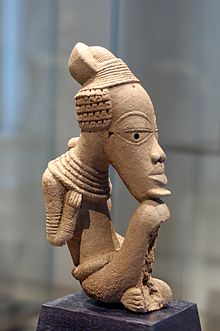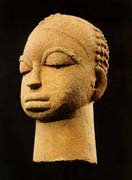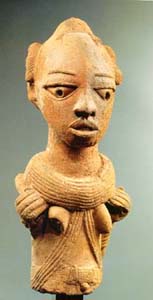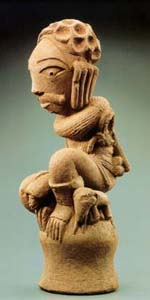THE MYSTERIOUS NOK (1600 BC)
Printed From: History Community ~ All Empires
Category: Regional History or Period History
Forum Name: African History
Forum Discription: Talk about African History
URL: http://www.allempires.com/forum/forum_posts.asp?TID=30262
Printed Date: 13-May-2024 at 01:48
Software Version: Web Wiz Forums 9.56a - http://www.webwizforums.com
Topic: THE MYSTERIOUS NOK (1600 BC)
Posted By: Felakuti
Subject: THE MYSTERIOUS NOK (1600 BC)
Date Posted: 18-Sep-2011 at 20:34
|
The Nok culture appeared in http://en.wikipedia.org/wiki/Nigeria - Nigeria around http://en.wikipedia.org/wiki/1000_B.C. - 1000 B.C. and mysteriously vanished around 500 AD in the region of West Africa. This region lies in Central Nigeria. The culture’s http://en.wikipedia.org/wiki/Social_system - social system is thought to have been highly advanced. The Nok culture was considered to be the earliest http://en.wikipedia.org/wiki/Sub-Saharan - sub-Saharan producer of life-sized http://en.wikipedia.org/wiki/Terracotta - Terracotta . It is suggested that the society eventually evolved into the later http://en.wikipedia.org/wiki/Yoruba_people - Yoruba Kingdom of http://en.wikipedia.org/wiki/Ife - Ife . The refinement of this culture is attested to by the image of a Nok dignitary at the http://en.wikipedia.org/wiki/Minneapolis_Institute_of_Arts - Minneapolis Institute of Arts . The dignitary is portrayed wearing a "shepherds crook" affixed with an elastic material to the right arm ( http://www.metmuseum.org/toah/hd/nok/hd_nok2.htm - [3] , http://www.artsmia.org/viewer/detail.php?id=5368&v=12&dept=8 - [4] ). The dignitary is also portrayed sitting with flared nostrils, and an open mouth suggesting performance. According to some accounts, based on artistic similarities to both early http://en.wikipedia.org/wiki/Yoruba_traditional_art - Yoruba art forms and Nok forms, there may be connections between them and the contemporary Yoruba people. Later brass and terracotta sculptures of the http://en.wikipedia.org/wiki/Ife - Ife and http://en.wikipedia.org/wiki/Benin_Empire - Benin cultures show significant similarities with those found at http://en.wikipedia.org/wiki/Nok - Nok . Iron use, in http://en.wikipedia.org/wiki/Smelting - smelting and http://en.wikipedia.org/wiki/Forging - forging for tools, appears in Nok culture in Africa at least by http://en.wikipedia.org/wiki/550_BC - 550 BC and more probably in the middle of the second millennium BC (between 1400 BC and 1600 BC) http://en.wikipedia.org/wiki/Nok_culture - http://en.wikipedia.org/wiki/Nok_culture Nok dignitaries (circa 1600 BC)
|
Replies:
Posted By: Nick1986
Date Posted: 19-Sep-2011 at 09:23
|
What was the function of their terracotta statues? Were they intended for ceremonial-purposes or was there an export trade? ------------- Me Grimlock not nice Dino! Me bash brains! |
Posted By: Felakuti
Date Posted: 19-Sep-2011 at 16:31
|
''Researchers are still not sure what these peculiar [Nok] adornments are supposed to indicate. Since stone pavement is often found near the statues, some have thought that they were situated in holy places or near altars. The archeologists have found remnants of deliberately deposited jewelry chains alongside them, which might lend some degree of support to this hypothesis.'' http://www.modernghana.com/newsp/234405/1/pagenum2/german-archaeologists-labor-to-solve-mystery-of-th.html - http://www.modernghana.com/newsp/234405/1/pagenum2/german-archaeologists-labor-to-solve-mystery-of-th.html
|
Posted By: Nick1986
Date Posted: 19-Sep-2011 at 19:38
|
So these were used for the worship of gods or dead ancestors? What were the Nok's religious-beliefs? ------------- Me Grimlock not nice Dino! Me bash brains! |
Posted By: Felakuti
Date Posted: 19-Sep-2011 at 23:43
|
There would have been a multiplicity of deities and the recognition of a Supreme Being, with the former regarded as 'emissaries' or 'facilitators' of the latter, and thus constantly beseeched for assistance in one form or another by the people. Each Nok village or neighbourhood (in cities) would have had a particular deity that was popular in it's territory. Likewise, individuals would have been free to choose their own deity out of what would have been scores of them known to the people, their choice dependent on anything from following family tradition, to a barren woman choosing to venerate a fertility goddess, in the hope of giving birth.
|












